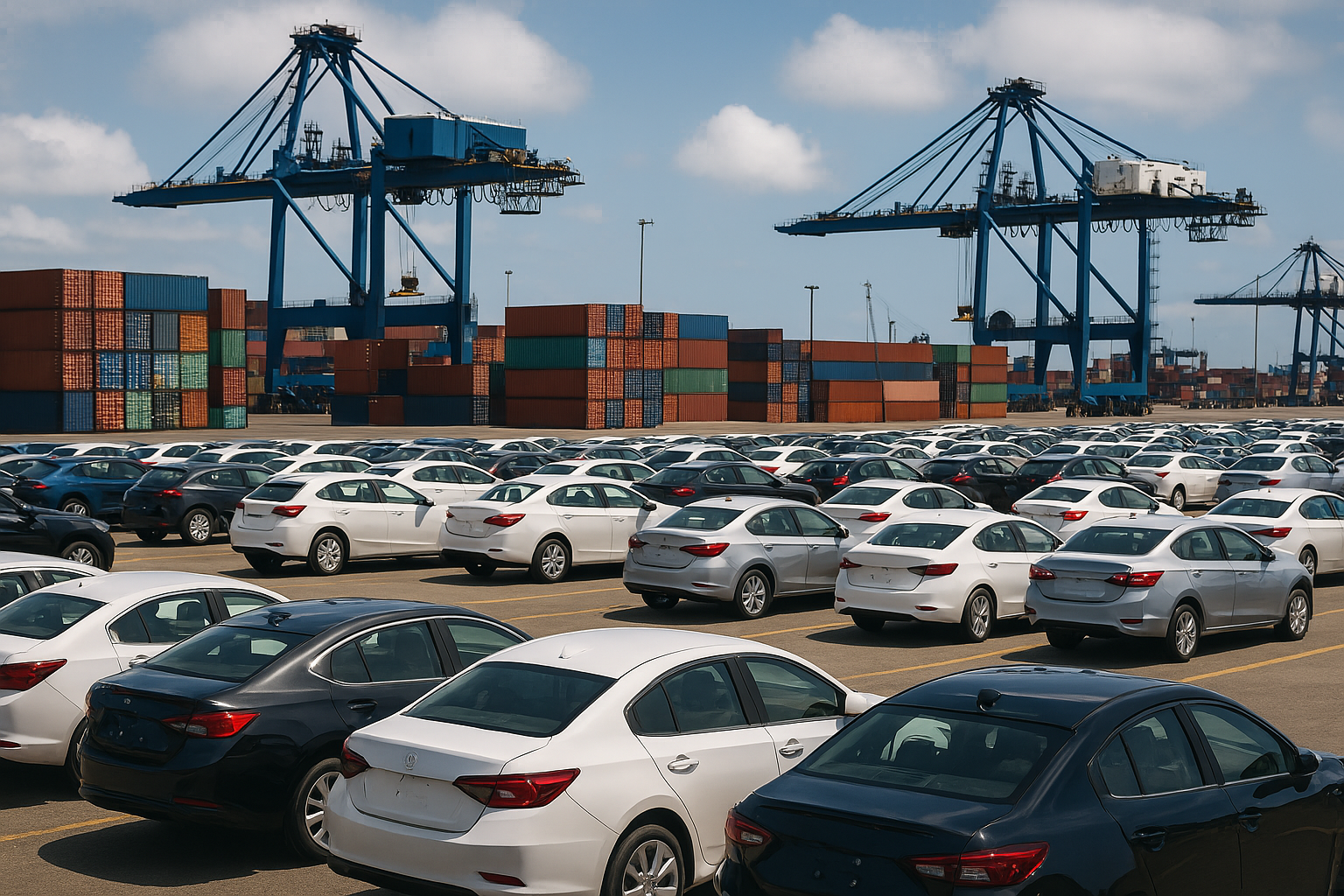Surge in American Car Imports & International Car Shipping
The global automotive industry is in the middle of a historic surge in car imports and exports. Sharp shifts in tariff policy, a strong dollar abroad, and booming demand for iconic American cars have combined to create record volumes of vehicles moving across oceans. This 2025 guide explains why the world suddenly wants so many American cars, how the import boom is changing international car shipping, and what buyers, sellers, and shippers must know to stay ahead.
Outline
-
Why Is There a Record Surge in American Car Imports?
-
How Do 2025 Tariffs Drive the Current Import & Export Climate?
-
Which Export Markets Are Absorbing the Most American Muscle Cars?
-
What Shipping Method Cuts Costs for Classic Car Exports?
-
Are Luxury EV Exports Changing Global Automotive Demand?
-
How Do Currency Shifts Affect Shipping Costs in 2025?
-
Why Is Container Shipping the Backbone of Global Car Transport?
-
How Do U.S. Car Shows and Auctions Fuel International Demand?
-
What Compliance Steps Must Importers Follow for U.S. Vehicles Overseas?
-
Where Does West Coast Shipping Fit Into the Global Market Surge?
1. Why Is There a Record Surge in American Car Imports?
The 2025 import boom can be traced to three fast-moving trends that have reshaped the global automotive market:
-
Classic car exemptions. The 25-year rule allows pre-2000 models to bypass modern safety requirements, making every classic American muscle car from 2000 or earlier instantly cheaper to land overseas. West Coast Shipping’s analysis of the classic car import surge shows imports up 37% year-over-year.
-
Tariff avoidance. Buyers abroad view older cars as an antidote to the 25% tariff on imported vehicles that still applies to modern models.
-
Cultural appeal. Iconic American vehicles—models like the Ford Mustang and Chevrolet Camaro—carry global prestige, stoking demand in emerging export markets such as Saudi Arabia and Australia.
For many overseas enthusiasts, importing a well-preserved 2000 Mustang GT is now an affordable car dream compared with buying new vehicles priced thousands higher after the latest tariff hikes.
2. How Do 2025 Tariffs Drive the Current Import & Export Climate?
The April 2025 25% tariff on imported vehicles and the looming 25% duty on auto parts have created a two-tier car market:
-
New imports: Buyers pay full duties, pushing them toward electric vehicle options built in tariff-friendly regions or away from new imports altogether.
-
Classic imports: Vehicles over 25 years old still face only a 2.5% duty, widening the price gap and intensifying the surge in classic car imports from the United States.
At the same time, tariff threats against EU cars—including a potential 50% duty—have triggered fast-track shipments of European luxury brands into U.S. ports before new fees take effect. West Coast Shipping’s tariff strategy guide details how importers rushed to beat the deadline, adding volume to an already strained global automotive supply chain.
3. Which Export Markets Are Absorbing the Most American Muscle Cars?
Export markets in the Middle East, Europe, and Australia are driving record demand for U.S. vehicles:
-
Saudi Arabia tops the list for high-horsepower American muscle car imports, thanks to relaxed fuel-economy rules and a thriving collector scene.
-
Germany, Netherlands, and France remain the largest European destinations for classic American pickups and sports cars, drawn by favorable classic-status tax breaks.
-
Australia has become a right-hand-drive conversion hub, importing U.S. trucks and Mustangs for local resale.
Data compiled in the International Car Shipping Report shows containerized exports to these regions up 22% compared with 2024, despite higher freight rates.
4. What Shipping Method Cuts Costs for Classic Car Exports?
Container shipping remains the safest and most flexible way to ship cars, but 2025 trends favor shared containers for affordability:
-
Shared container service lets two or three cars split the cost while enjoying sealed-box protection.
-
For larger volumes—dealers moving 4-6 vehicles—full 40-ft containers provide a low per car rate that often beats RoRo on total cost.
-
RoRo still works for mass-market, running vehicles, but high-end buyers value the extra security of containers.
West Coast Shipping’s classic car guides explain how proper blocking, bracing, and moisture control protect collector cars during long ocean transits.
5. Are Luxury EV Exports Changing Global Automotive Demand?
A parallel surge is reshaping the electric vehicle segment. According to the EV export boom report, U.S. EV exports jumped 340% in 2024. Tesla’s Model Y and Rivian’s R1T account for most of the volume.
-
Emerging markets with EV incentives, such as the UAE and Norway, now import thousands of U.S.-built EVs annually.
-
Battery-safe containers equipped with climate monitoring have become essential to prevent thermal events during long ocean crossings.
For exporters, the rise of EV shipping diversifies cargo but also adds compliance layers—lithium-ion battery regulations, port fire-suppression rules, and specialized hazard labels.
6. How Do Currency Shifts Affect Shipping Costs in 2025?
A 6% slide in the U.S. dollar in early 2025 has given foreign buyers a built-in discount on cars from the United States. The currency drop, detailed in West Coast Shipping’s exchange-rate analysis, makes a $50,000 Corvette effectively cost €2,700 less for a European buyer than it did just months earlier.
Lower dollar value pairs with tariff-driven discounts on classics, creating a “double incentive” to import now: cheaper purchase prices and lower duty rates. For U.S. sellers, this means:
-
Bigger international buyer pool
-
Faster auction hammer prices at events like Monterey Car Week
-
Higher profit margins when invoiced in dollars
7. Why Is Container Shipping the Backbone of Global Car Transport?
Despite advanced RoRo networks, container shipping dominates the global car shipping business for three reasons:
-
Flexibility. Containers move on any vessel, bypassing congested car-carrier berths and accessing inland rail or truck networks directly from port.
-
Security. Sealed steel boxes prevent theft, vandalism, and weather exposure—critical for high-value collector car and luxury car cargo.
-
Tariff mitigation. Consolidated loads reduce shipping costs per vehicle, offsetting tariff hikes for importers.
West Coast Shipping leverages dedicated export warehouses near Oakland, Miami, and New Jersey to load up to 40 containers a day, making the company a key hub in the global market for classic and luxury vehicles.
8. How Do U.S. Car Shows and Auctions Fuel International Demand?
High-profile events like Monterey Car Week and Barrett-Jackson Scottsdale drive sudden spikes in export bookings as foreign collectors snap up headline lots:
-
A record 45 vehicles left Monterey in 2024 aboard West Coast Shipping containers destined for Europe and the Middle East.
-
Car shows act as real-time barometers for foreign appetite—if Saudi buyers bid aggressively on rare Camaros, shipping lines see bookings surge within days.
-
Auction houses increasingly schedule dedicated export inspection windows so overseas buyers can finalize paperwork on-site.
Our behind-the-scenes coverage, Inside Monterey Car Week, breaks down how global bidders ship purchases home securely.
9. What Compliance Steps Must Importers Follow for U.S. Vehicles Overseas?
Every destination has its own import process, but common checkpoints include:
-
Customs clearance paperwork—commercial invoice, foreign registration, and bill of lading.
-
Proof the vehicle meets or qualifies for exemption under local safety and emissions rules; many nations waive modern standards for vehicles older than 30 years.
-
Payment of duties—ranging from 2% on classics in Germany to 35% on high-displacement engines in Nigeria, as outlined in our guide to shipping cars to Africa.
Importers should consult local exporter partners to navigate regional complexities, especially in markets facing new car tariffs or where EV battery certifications are mandatory.
10. Where Does West Coast Shipping Fit Into the Global Market Surge?
With warehouses on both U.S. coasts, direct contracts with major ocean carriers, and weekly sailings to 48 countries, West Coast Shipping sits at the center of the 2025 international car boom. The company’s strengths include:
-
Shared container programs that reduce costs for small dealers and individual buyers.
-
In-house customs clearance teams who navigate the ongoing tariff maze.
-
Specialized loading for everything from classic American muscle to battery-packed luxury EVs.
When you need to ship a car overseas—whether a 1967 Fastback Mustang or a 2025 Tesla Cybertruck—West Coast Shipping provides the expertise to move vehicles safely, on time, and fully compliant with global regulations.
Key Takeaways for 2025 Car Import & Export Success
-
Classic 25-year-old models avoid hefty 25% duties, fueling a boom in imported vehicles.
-
Currency shifts make U.S. cars cheaper for buyers in Europe and the Middle East.
-
Container sharing and strategic port selection help reduce rising shipping costs.
-
Luxury EV demand adds new compliance layers for batteries and haz-mat paperwork.
-
Events like Monterey Car Week act as catalysts for sudden export volume spikes.
-
Professional logistics partners such as West Coast Shipping streamline every step—from export warehouse loading to overseas delivery—inside a volatile tariff environment.
Get Your Free International Car Shipping Quote
Ready to join the 2025 import & export surge? Use our instant shipping calculator below to compare routes, containers, and costs—and bring your American or imported dream car safely to its next destination.
You May Also Like
These Related Stories

US Car Import 2025: EV Rules, Classic Re-Imports & Global Source Rankings

Ship Cars To The US From UK: True Costs, Process & Compliance In 2025

-093789-edited.png?width=220&height=79&name=wcs_final_logo_(1)-093789-edited.png)
